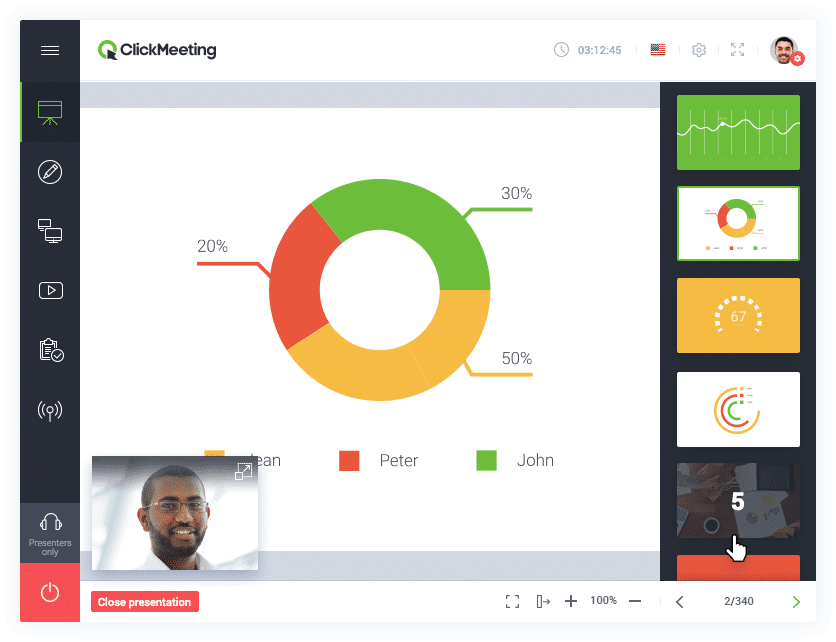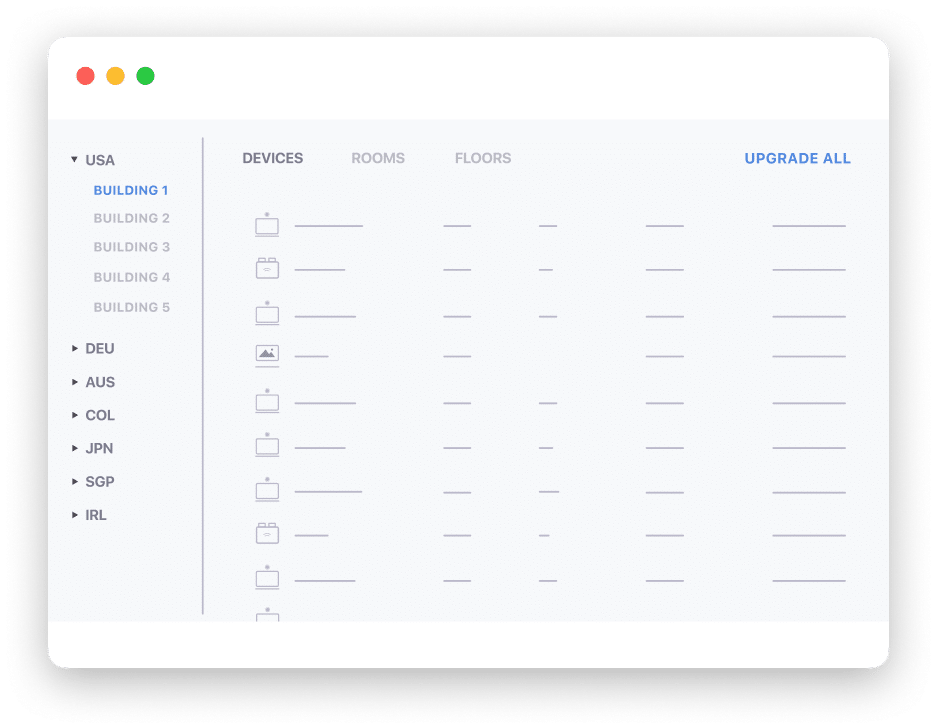Updated October 2020
If you’re looking for the best cloud-based video conferencing software, there are a few things to look for beyond just the basic ability to have a face-to-face conversation with someone on a screen.
If you’re planning to use this video conferencing software for your business or to get work done, there are even more nuances to be aware of as you’re shopping. (For example, security is a big one since you might be talking to clients on those calls.)
That’s why taking the time to compare different tools with specific use cases and requirements in mind is an important step in choosing your video conferencing solution.
Below, we’ll break down a few options in terms of features, integrations, pricing, and more—and show you how we got to each of those assessments.
So, which platform is the right one for your team?
In this article, we’ll look at:
- How to choose the right video conferencing software for you
- The 5 best video conferencing apps for 2020
🛒 Shopping for a video conferencing tool? (Or just curious about what to look for?) Grab the free checklist to help you choose the right one for your team or business.
How to choose the best video conferencing app that’s right for you
When picking software, it’s essential to look at the features and capabilities that match with your specific goals. (“The most expensive” doesn’t necessarily mean “the best.”)
Some software limits the controls participants have over meetings, while others integrate with other apps you use to organize your company’s daily life, like email and calendars. There’s lots to consider when you’re trying to choose the best video conferencing app for a small business.
When you’re shopping for video conferencing app software, think about:
- How many people will be using it: Take a look at the size of your current team, and consider how much you expect it to grow. Some software may have a limit on how many participants you can add to meetings, while others actually specialize in larger conferences.
- What types of meetings it hosts: Will you just be having face-to-face virtual meetings, or do you need it to do a little more? While some apps cover the bare essentials (video link-ups, messaging, etc.), others host meetings where team members can be muted, participate in open-forum Q&As, and give presentations. If your team is big on group brainstorming and collaboration, you’ll need a video conferencing software with these features.
- How mobile-friendly it is: Part of what makes remote work so great is how accessible it is to everyone, no matter where they are. So, if a team member needs to jump on a meeting and they only have their phone handy, that should be A-okay. Check if the video conferencing software you’re looking to invest in works on tablets and smartphones to avoid this problem.
- Does it have virtual conference rooms: Virtual conference rooms allow different teams at your company to host meetings as if everyone were—you guessed it—in a conference room. Video conference rooms typically mirror in-person conference rooms (aka focus rooms, huddle rooms, training rooms) so you can provide the same experience to your team. These rooms usually have added extras, like online whiteboards, to add to the experience.
Now that you know what you should look for in a video conferencing app, let’s take a look at your top five options for 2020.
5 best video conferencing apps for 2020
Best all-around video conferencing app: RingCentral Video
RingCentral Video is a complete video conferencing solution for businesses. And when we say “complete,” we mean it.
Not only does it offer HD video conferencing, there’s also team messaging, screen sharing, and large-scale webinars, meaning you can host meetings for up to 500 people.
It’s also completely mobile-friendly—whether your team is joining from a smartphone, tablet, or desktop, their experience will be the same.
Now, there are a few features that make RingCentral really stand out, especially for a business.
RingCentral’s unique features
1. Join in one click from a web browser—no download needed
If you or your attendees are just joining (not hosting) a virtual meeting, you don’t have to download anything. Just join from a web browser:
On the other hand, if you need some of the more advanced controls like whiteboards or multiple shared screens, you can do that by joining from the desktop or mobile app.
2. Create, manage, and assign tasks
After your video call with a teammate, you might need to follow up with some tasks. No problem. Just stay in the RingCentral app and open up a new task. Fill out the details, attach a file if you need to, assign it to someone:
RingCentral is a PCMag’s Editors’ Choice Award winner because of its reliable service and easy-to-use app (among other reasons)!
3. Share files
You can also upload files to a team chat from your computer. Or alternatively, you can upload a file from Dropbox, Box, or Google Drive too:
4. Annotate documents on calls
On a video call with your team? Collaborate and annotate documents together in real time:
Finally, there’s next to no learning curve. To start using it, all you need to do is download the RingCentral app for Android, iOS, Mac, or PC.
🤯 On top of all this, RingCentral could save you up to $400 an hour in IT costs.
Explore the RingCentral Advantage for small businesses:
💰 You can also use this calculator to see roughly how much your business could save by using RingCentral to support your team’s communications with clients, customers, and each other.
Pricing
RingCentral Video comes included in the RingCentral Office® package, which you can get in three tiers starting at $19.99 per user per month.
Best video conferencing app for Google Workspace users: Google Hangouts

Are you searching for a video conferencing app that’s free? Well, Google Hangouts has you covered.
The tool, which was initially an offshoot to Google+, allows teams to host video conferences right from Google Workspace. All you need to do is set up a meeting and share the link with your colleagues. The direct integration with Google Workspace means you can join meetings straight from your Google Calendar without needing to install a plugin or create an account.
The free version of Google Hangouts has all of the basics packed into it, like video, audio, and messaging. Not only can you record your video meetings to keep on file (or share with your team members who missed out), you can also share your screen with everyone that’s attending.
Google Hangouts is geared towards smaller teams (unless you want to pay), so meetings are capped at 25 participants. However, Google has developed its own line of Hangouts Hardware, which allows teams to create a virtual conference room using speaker mics, state-of-the-art cameras, and wide-field-of-view cameras.
If you’re just conducting in-house meetings, you probably don’t need it. For larger companies, though, it’s a great way to upgrade your conference room for a fraction of the typical price.
The biggest draw of Google Hangouts is its price tag—it doesn’t have one. While other platforms on the list might charge a monthly fee, Google Hangouts is a good option for teams who want to see what video conferencing software is all about before investing in a more advanced platform.
The downfall of Google Hangouts—like with most free options out there—is that it lacks a lot of features. While other options on our list, like RingCentral, have pretty robust options for teams to collaborate using virtual whiteboards and larger meetings, Google Hangouts falls a bit short here.
The software also doesn’t have a unified messaging solution, so it’s not great for teams who like to share links and information during meetings.
Best video conferencing app for mobile meetings: GoToMeeting

If your team is on the move, GoToMeeting might be a good option for you.
It offers standard features like video, audio, and screen sharing—and also a set of features geared towards mobile-friendliness. You can start a video call right from the GoToMeeting app from anywhere in the world and have it replicate a virtual conference room.
Every aspect of the meeting, from the scheduling to the calling, can be done right from your mobile device.
GoToMeetings works seamlessly across Safari, Chrome, Internet Explorer, and Firefox, which means your team can continue to use their preferred browser (if you aren’t using the app).
Although GoToMeeting is packed with features, one of the main downsides to this option is the cost. It’s a little more expensive than other options on our list—without offering any unique features that make the heftier price tag worth it.
Best video conferencing app for training teams: ClickMeeting

ClickMeeting is a popular video conferencing app for small teams—and when we say small teams, we mean four video streams. Tops.
But what ClickMeeting lacks in attendance numbers, it makes up for in options. The software has a suite of presentation tools so you can do things like present slides and share your screen with others to show information. There’s also a dial-in and VoIP calling option to give your attendees more attendance and collaboration options.
One of the main draws of ClickMeeting is that it’s multilingual. Because of its integration with Google Translate, the app is available in 11 languages, and if your team is using the chat, it can be translated into 52 different languages. The typed text, as well as the translated version, are shown side-by-side in the tool’s chatbox, which encourages your teammates to interact in their native languages.
The software has onboarding features so you can schedule training sessions, send out custom branded invitations to onboarding sessions, and use the Q&A function to test the knowledge of your new team members:

An example of a meeting presentation using ClickMeeting
Although it’s hard to fault ClickMeeting’s software, the lack of phone support is a definite negative. Free accounts have to reach out to a customer support email address for help, while paid accounts have live-chat support during set hours. If you want to talk to a human being over the phone, it might take a while.
Best video conferencing app for quirky extras: Zoom

Zoom has become one of the best-known video conferencing apps in the world because of one reason: its options. (Want to have a beachy background behind you while you’re on a video call? Zoom’s got it.)
Like RingCentral, the platform lets you host a video conference using a URL link. Setup is relatively easy—just create an account and start a meeting.
Zoom also has a feature called Zoom Rooms, which emulates a real-life conference room. All you have to do is reserve a room for your meeting, send out the invites, and you’re done:

The Zoom Room booking system is designed for larger companies that need to host several video conference calls at a time.
Zoom allows teams to host an unlimited number of meetings per month and has a handy chat feature inside the software that lets you message each other both privately and in groups.
If you’re thinking of consolidating all your communications into a single tool, though, note that Zoom doesn’t have toll-free dial-in numbers set up for UK or US customers—if someone wants to patch in to a call by phone, it’ll be a bit of a challenge.
And even though the platform does have free video conferencing for the most basic plan, there are a few limitations. Virtual conferences can’t be longer than 40 minutes, and none of the advanced features—like support and custom meeting IDs—can be accessed for free.
Curious about options other than Zoom? Download this Zoom Alternatives Comparison Chart.
What’s the best video conferencing app for you?
Investing in the right software for your team will depend on a whole host of factors.
Do you want to use it for training? Are you hoping to host in-depth virtual meetings using online whiteboards and presentations? Or do you just want a tool that’ll let you have one free video calls with one person at a time?
In our humble opinion:
- RingCentral is the best video conferencing option for teams and businesses that do quite a bit of their collaboration online, which entails them needing features like screen sharing, file sharing, and task management.
- Google Hangouts is better if the most important thing for you is having something free, and you just want the basics.
- ClickMeeting is the best option if you do need those bells and whistles, but you have a very small team. (We’re talking less than five people.)
And, while we’d love to be the perfect video conferencing tool for every team out there, we have to be honest—there’s no one tool that’s a “perfect fit” for every businesses.
Whatever software you decide to invest in, make sure it fits your goals and the way your team works. Don’t just go with the option with the most features or the cheapest price tag. The right video conferencing software can boost collaboration and dramatically cut your onboarding training times, so choose wisely!
Originally published Oct 31, 2020, updated Jul 25, 2024










